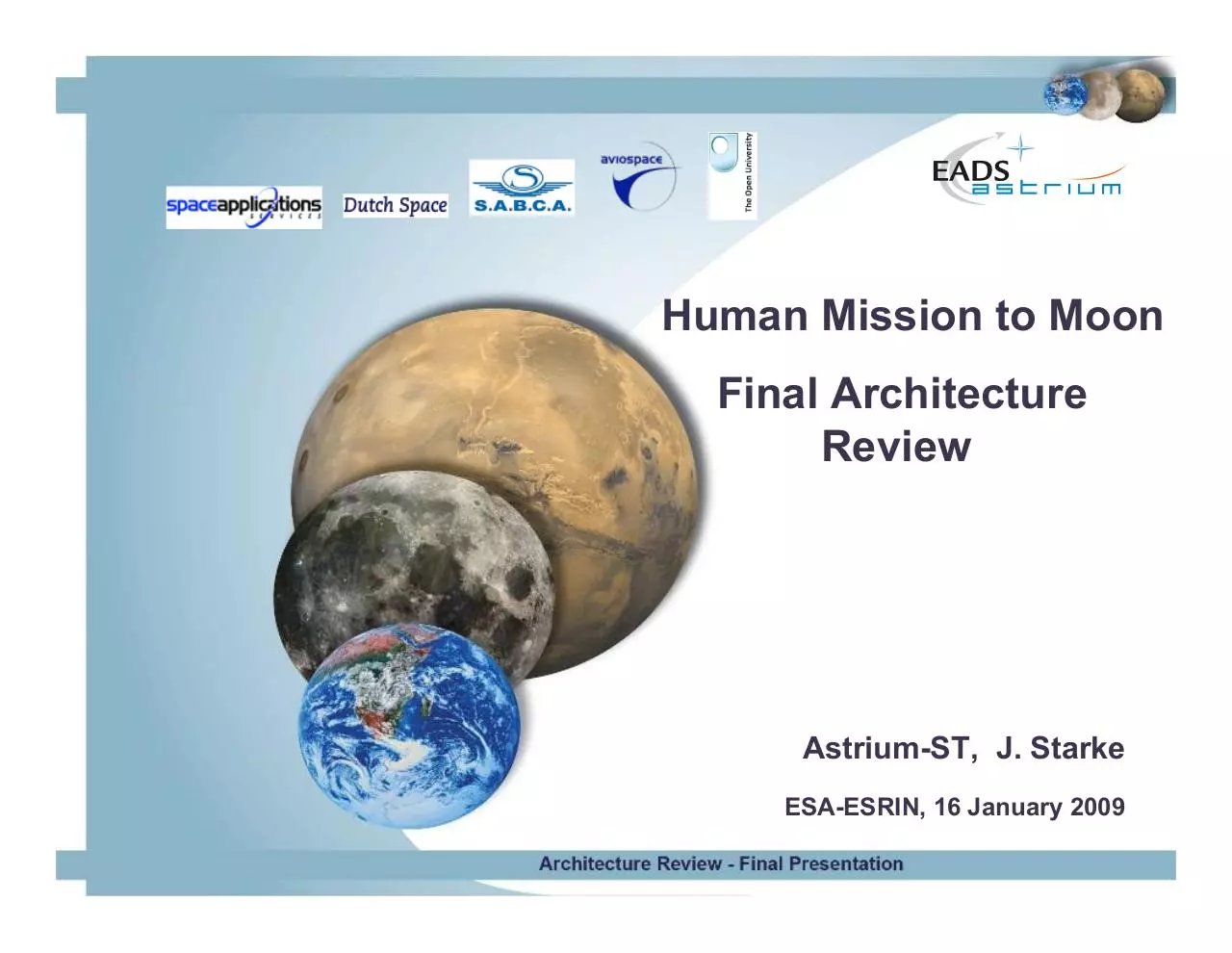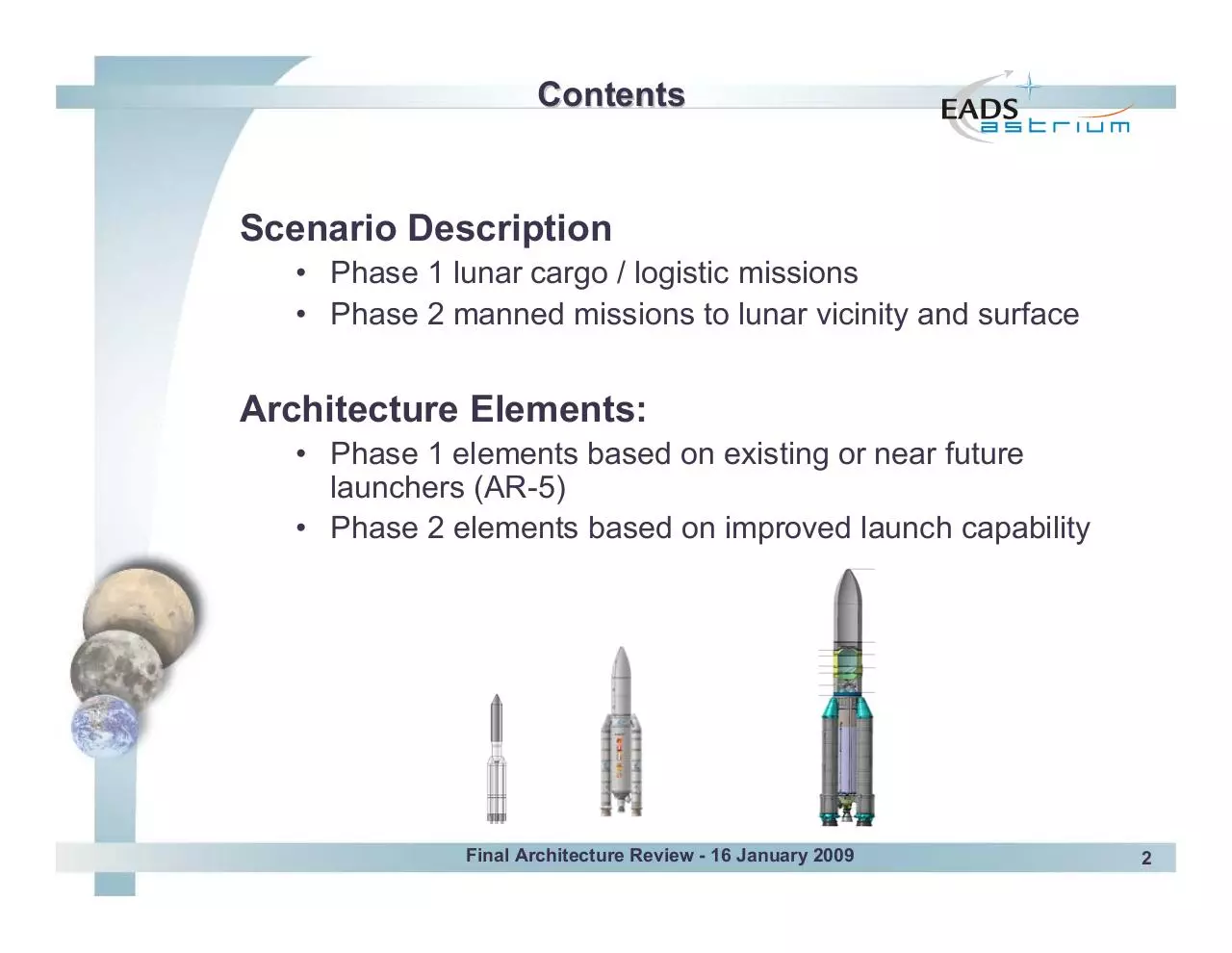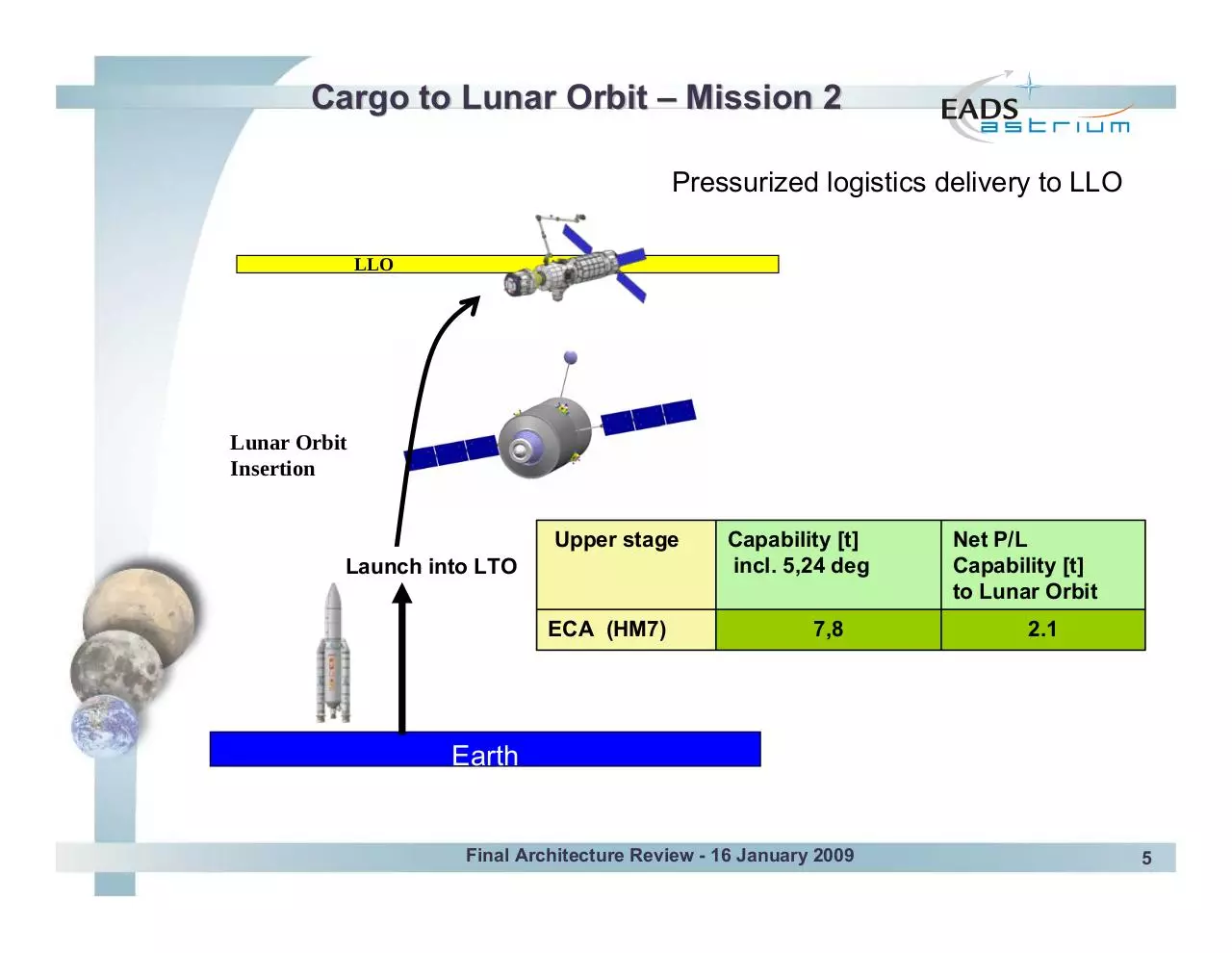04 Human moon mission version9esa120109 (PDF)
File information
Title: Slide 1
Author: jmyrrhe
This PDF 1.4 document has been generated by Acrobat PDFMaker 7.0.5 für PowerPoint / Acrobat Distiller 7.0.5 (Windows), and has been sent on pdf-archive.com on 12/07/2020 at 00:28, from IP address 90.32.x.x.
The current document download page has been viewed 267 times.
File size: 962.9 KB (22 pages).
Privacy: public file





File preview
Human Mission to Moon
Final Architecture
Review
Astrium-ST, J. Starke
ESA-ESRIN, 16 January 2009
Final Architecture Review - 16 January 2009
1
Contents
Scenario Description
• Phase 1 lunar cargo / logistic missions
• Phase 2 manned missions to lunar vicinity and surface
Architecture Elements:
• Phase 1 elements based on existing or near future
launchers (AR-5)
• Phase 2 elements based on improved launch capability
Final Architecture Review - 16 January 2009
2
Missions & Scenarios
Mission 1: Cargo to Lunar Surface
Cargo/ logistic transport to Lunar surface injected by one
Ariane 5
Mission 2: Cargo to Lunar Orbit
Cargo / logistic transport to Lunar orbit injected by one Ariane 5
or using two Ariane 5
Scenario 1: Assembly in LLO
2 Assemblies in LEO of manned lunar mission, separate transfer
of crew vehicle and lunar descent and ascent vehicle to LLO
and transient of crew in LLO station
Scenario 2: Assembly in LEO
Assembly in LEO of the entire manned lunar mission
system (comparable with Apollo scenario)
Final Architecture Review - 16 January 2009
3
Cargo to Lunar Surface - Mission 1
Moon
Moon Landing
LLO
Lunar Orbit Insertion
Launch into LTO
Upper stage
Launch
Capability [t]
Payload on
Surface [t]
ECA (HM7)
7.8
1.2
ECB (Vinci)
9.7
1.7
Upper stage
Capability [t]
incl. 5,24 deg
Capability [t]
incl. 18 deg
ECA (HM7)
7.8
6.8
ECB (Vinci)
10.2
9.7
Earth
Final Architecture Review - 16 January 2009
4
Cargo to Lunar Orbit – Mission 2
Pressurized logistics delivery to LLO
LLO
Lunar Orbit
Insertion
Upper stage
Launch into LTO
ECA (HM7)
Capability [t]
incl. 5,24 deg
7,8
Net P/L
Capability [t]
to Lunar Orbit
2.1
Earth
Final Architecture Review - 16 January 2009
5
Human transportation scenario 1
•Provide incremental access to LLO first, then to
Lunar surface
•LLO Orbital infrastructure to support LLO missions
and to provide cooperation opportunities with
NASA architecture
• Launch of 50 t EDS (cryogenic system)
• Launch of combined payload + small transfer stage (cryo) and LEO
assembly
• Injection into eccentrical orbit
• Small transfer stage complements injection into TLI and LOI with
cryo propellant
• Docking at the LLO station
Up to 6 months
Up to 1 month
50t LV
• Launch of 50 t EDS
• Launch of crew vehicle and
assembly in LEO
• Injection of the crew vehicle
into LLO by EDS
• Docking of the crew vehicle
with LLO station
50t LV
50t LV
Man-rated LV
Final Architecture Review - 16 January 2009
6
Human transportation scenario 2
•Provide assembly in LEO first, injection into LLO
•Separation in LLO and descent to Lunar surface
•Ascent to LLO and RvD with orbiting crew
vehicle
•Transient of crew into the return vehicle and
•Return to earth of the crew
LEO Assembly Station
50t LV
50t LV
50t LV
Final Architecture Review - 16 January 2009
Man-rated LV
7
Transfer sequence for scenario 2
1st EDS
injection into earth ellipse
3rd eds
13700 km
injection into LLO
2nd EDS
injection into LTO
Hohmann transfer
capability
TLI 3200 m/s
ΔV per stage
1st 1250 m/s
ΔV per stage
2nd 1950 m/s
ΔV per stage
LOI 1000 m/s
3rd 1000 m/s
Final Architecture Review - 16 January 2009
8
Discussion of scenario 1
Advantages of LLO transient of crew (scenario 1)
•
•
•
•
•
Separate transport of crew and lunar descender and
ascender to LLO
Low number of RvD’s in LEO per lunar transport (moderate
waiting time in LEO, reduced boil off)
Higher acceleration level per lunar transport (lower gravity
losses)
Scenario needs smaller infrastructure effort in LEO
Scenario is more flexible because it allows also crew only to
LLO or cargo to lunar surface
Final Architecture Review - 16 January 2009
9
Major scenario elements
Transportation Elements:
• Launchers
• Cargo Lander
• Crew transportation vehicle
• Manned descent and ascent stage
• Earth departure stage(s) (EDS)
• Service Modules
In-space architecture elements
• LEO and LLO infrastructure
Final Architecture Review - 16 January 2009
10
Typical Launcher
Launcher evolution to 50 t LEO class :
•
•
•
•
6 boosters configuration
1 core stage
Upper stage with 2 VINCI
Overall length ~ 60 m
Upper
stage
Vinci
Twin
chamber
Final Architecture Review - 16 January 2009
11
Logistic transportation to LLO
payload
2100 kg
Pressurized logistics
Transporter
Attitude Control
Thruster Cluster
Dry mass
3240 kg
Isp
460 s
DV
1600 m/s
Propellant
2290 t
TOTAL
MASS
7800 kg incl.
adapter
Comms
Antenna
Solar Generator Wings
Docking
Mechanism
to LSS
Cargo Module
(pressurized)
Propulsion &
Avionic Module
Final Architecture Review - 16 January 2009
12
Cargo / logistic lander
Communication
antenna
Payloads
Cargo Lander
Payload
1750 kg
Dry mass
1680 kg
Isp
325 s
DV
2320 m/s
Propellant
6040 t
TOTAL
MASS
9700 kg incl.
adapter
Solar
generators
RCS
Descent stage : 1 engine 12 kN ( throttleable) or 3 engines of 4 kN constant thrust
Final Architecture Review - 16 January 2009
13
Crew transportation scenario to LLO
Crew transportation system (3 crew) baseline
7,5 t
5,5 t
13 t
Capsule
Service module
TOTAL
Docking
system
50 t class for EDS transfer to LLO
Propulsion
RCS
Usable
propellant
3t
Isp
320 s
DV*
1380 m/s
Total
(without adapter)
13 t
Power
generators
Final Architecture Review - 16 January 2009
14
EDS versions
24 t EDS
Usable
propellant
17.5 t
Isp
460 s
DV
(P/L ≈ 26 t)
2030 m/s
Total (without
adapter)
23,8 t
One VINCI
Main
engine
Total TEI + LOI: ΔV 4320 m/s
50 t EDS
Usable
propellant
39 t
Isp
460 s
DV
(P/L ≈ 50 t)
2290 m/s
Total
(without
adapter)
49 t
stage
Docking
system
Solar
generators
Main
engines
Two VINCI
Final Architecture Review - 16 January 2009
Adapter
cone
Launch loads
15
Human lander transportation scenario
Docking
system
Ascent stage
Dry mass
3615 kg
Isp
325 s
DV
2258 m/s
Total mass
7.5 t
Crew
Cabin
Air lock
port
Storable
Propellant
tanks
Descent stage
Dry mass
4851 kg
Isp
325 s
DV
2260 m/s
Total w/o
payload
18.7 t
Ascent stage
4 engines :
12 kN
Descent stage
1 engine. 70 kN ( throttleable)
IBDM docking system
AOCS
thruster cluster
Body mounted
solar arrays
Total stack to inject into LLO: 26.2 tonnes
Final Architecture Review - 16 January 2009
16
Launch Scenario
Major Dimensions:
Launcher fairing diameter ~ 6 m
Diameter:
5.2 m (cylinder)
Height:
- Ascend stage:
- Descend stage:
- EDS
4.4 m
4.6 m
7,5 m
-Combined config.
16,5 m
Final Architecture Review - 16 January 2009
17
Annex
Back up
Final Architecture Review - 16 January 2009
18
Gravity losses
SC 1: 100 t initial mass (2 VINCI)
⇒ 0,37 g => additional ΔV ≈ 30 m/s
⇒ Number of lunar transfer orbits = 2
⇒ EDS burn time 8 min
SC 2: 163 t initial mass (2 VINCI)
⇒ 0,22 g => additional ΔV ≈ 100 m/s
⇒ Number of lunar transfer orbits = 2
Additional ΔV for TLI (3200
m/s) as function of the
initial thrust to weight ratio
or acceleration level [g]
Final Architecture Review - 16 January 2009
19
Gravity loss calculations ( 163 t)
1. boost: 300 x 7000 km 78,2 - 106 m/s losses
2. boost: 300 x 400000 km 143 m/s losses achieved orbit: 323000
km apogee
One boost approach 163 t with 80 t propellant
Target orbit :
300 km x 400000 km
Achievements with different thrust orientations (360 kN)
• Tangential thrust: 631 km x 170000 km; loss ≈ 818 m/s
• Gravity turn:
540 km x 200000 km; loss ≈ 880 m/s
• Inertial direction: 329 km x 153000 km; loss ≈ 653 m/s
Final Architecture Review - 16 January 2009
20
Scenario 3 summary
Launcher
Elements + RvD
Mass
2 x HL
EDS (50t) +
Eds (24t) / Lunar sys
50 t
50 t
1. Mission
1 RvD LEO +1 RvD LLO
100 t
1 x HL +
EDS +
CTV (CM +SM)
50 t
13 t
2. Mission
1 RvD LEO +1 RvD LLO
63 t
3 HL +
4 RvD for transfer to LLO
163 t
Man-rated
launcher
1 man-rated
Final Architecture Review - 16 January 2009
21
Scenario 4 summary
Launcher
Elements + RvD
Mass
2x HL
EDS (50t) + EDS (50t)
1 RvD
50 t
50 t
1xHL
eds (24t) +Ascender / Descender 50 t
1 RvD
Man-rated
CTV + 1 RvD
13 t
3 HL +
3 RvD to LLO
163 t
1 man-rated
Final Architecture Review - 16 January 2009
22
Download 04 Human moon mission version9esa120109
04_Human_moon_mission_version9esa120109.pdf (PDF, 962.9 KB)
Download PDF
Share this file on social networks
Link to this page
Permanent link
Use the permanent link to the download page to share your document on Facebook, Twitter, LinkedIn, or directly with a contact by e-Mail, Messenger, Whatsapp, Line..
Short link
Use the short link to share your document on Twitter or by text message (SMS)
HTML Code
Copy the following HTML code to share your document on a Website or Blog
QR Code to this page

This file has been shared publicly by a user of PDF Archive.
Document ID: 0001939451.